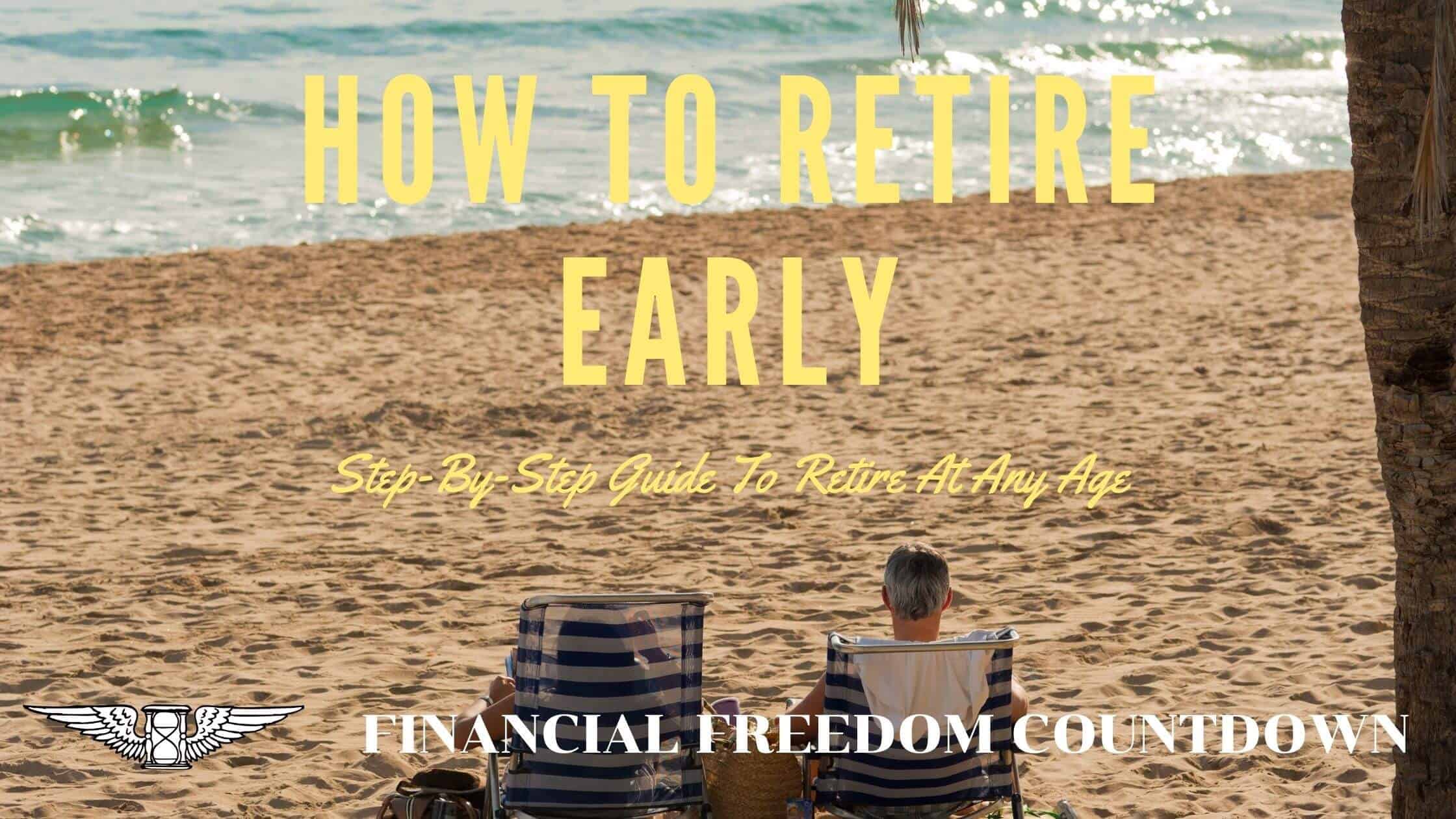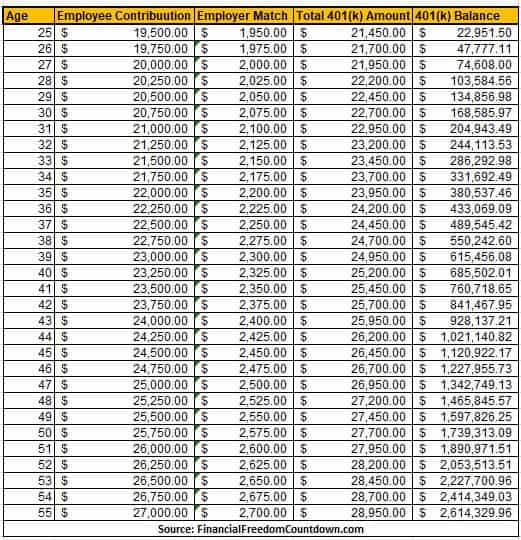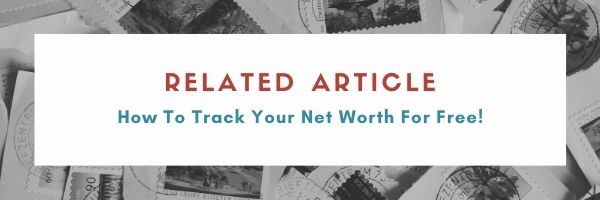How To Retire Early: Step-By-Step Guide To Retire At Any Age

Many of us will likely spend decades working for a company before we can retire.
But what if you could escape the rat race and retire early? What if you could do it without taking on an enormous amount of risk or sacrificing your standard of living?
If you wonder how to retire early but are unsure how to start, here are the steps.
- Determine how you want to live in retirement
- Create a budget based on how you will be living in retirement
- Estimate your expenses for retirement activities
- Estimate how much money you need annually to retire based on your needs and wants
- Evaluate your current financial situation
- Make lifestyle changes
- Meet with a certified financial planner to validate if you are on the right track
- Test run your life for a year on your retirement budget
- Retire and be flexible
This article will tell you an approachable way to save money, invest it wisely and enjoy financial freedom for yourself and your loved ones so you can retire early too!
Determine How You Want To Live In Retirement
Before you grab an early retirement calculator, figure out how you want to spend your time in retirement? Your budget depends on how you want to live in retirement. The way you want to live when you retire will determine how much money you need to have saved up before quitting your job and how long it will take for your savings to reach a point where they can support your income requirements. Figuring your retirement lifestyle is the first step in creating a financial plan.
Also, note that besides money, there are other aspects we need to figure out when asking the question of when can I retire?
Do you want to work part-time for the social aspect?
Do you plan on slow traveling and living in different countries for a more extended time? Or do you plan on taking a few cruises every year? Or do you plan an RV lifestyle for a few years visiting national parks?
Do you want to open a business like a bed and breakfast or a coffee shop? Or do you want to do volunteer work?
All of these retirement lifestyle choices come with different costs.
You will need to determine how you want to live in retirement, which will impact how much savings you need and how long you need to save for retirement.
“You can’t hit a target you can’t see.”
Financial Freedom Countdown
Create Your Retirement Lifestyle Budget
The best place to start is your current budget. If you do not have one or want to make sure your estimated current budget matches your actual spending, an easy way to do this is to sign up for a free account at Personal Capital. After your accounts are linked, you get a free current budget based on your cash flow and spending patterns which you can tweak. Read my Personal Capital Review on how I use it.
The first step is to calculate how much money you will spend each month after you retire. Begin by adding up unavoidable costs such as housing, food, clothing, utilities, transportation, insurance, and healthcare. All of these expenses form your essential budget, which you cannot avoid.
Ideally, you will be debt-free upon retiring. That implies no mortgage, credit card bills, outstanding medical expenses, and student loans, or other debts to pay off. However, if any payments are still owed, make sure they are included in your spending plan.
Of course, being mortgage debt-free is only a guideline. While it is great to avoid all debt, it might not be possible to prevent mortgage debt, especially if you are retiring early.
I took a cash-out refinancing loan after early retirement. But I’d advise against it.
Next, include any discretionary expenses you anticipate having, such as your current entertainment, travel, or hobbies.
Of course, keep in mind that your expenses may change as you approach different phases of retirement—for example, if you decide to stop taking life insurance, you no longer need to account for premiums. Alternatively, you may be paying for your child’s college now but not after a few years. This preliminary budget will serve as a sound basis for future adjustments; therefore, it is worth completing.
Estimate Your Expenses For Retirement Activities
An accurate estimate of how much you will need each month in retirement requires considering how your spending habits change when you retire.
The retirement activities budget is different from your current discretionary budget because you might engage in new and other hobbies. Or spend more time and money on the current hobbies.
If you plan for early retirement, ask yourself how much more money you are likely to spend.
For example, if you plan to join a golf club after early retirement, how much would the membership cost?
If you currently ski only once or twice a year, do you plan to ski more in early retirement, and what will that entail?
If you are hoping to travel more, how much will that cost? Do you intend to volunteer in your spare time? If so, how much will that take out of your budget each year? Think about how hobbies and other activities might change.
Estimate Your Annual Retirement Based On Needs And Wants
Add up your essential annual expenses
Add up your discretionary yearly expenses
Add up your yearly retirement activities expenses
Add all the annual expenses (essential, discretionary, retirement) to arrive at an approximate yearly retirement number.
Even after optimizing your tax planning strategies, taxes might be one of the highest “expense” items on your current budget. If you gradually draw your retirement nest egg or have a lower retirement income, you might be in a lower tax bracket.
On the other hand, healthcare expenses might increase in early retirement. Currently, most of your premiums are paid by your employer. Check the Healthcare exchanges to determine your anticipated insurance premiums, copays, and deductibles in the US.
Evaluate Your Current Financial Situation
Your Personal Capital Dashboard with accounts linked would show you the current value of all accounts along with your net worth.
At this point, you should have a good picture of your current assets and liabilities.
How To Retire Early With Stocks
Early retirement with a stock portfolio is easier than most people realize. You do not need to be an expert stock picker and can stick to a diversified, low-cost total stock market fund and still do great.
The low cost is essential because if your mutual funds have a 1% expense ratio, you lose 1% every year. And maybe your financial advisors charge more investment fees on top of the expense ratio, which further reduces your profit. I am a massive fan of M1Finance, which charges no investment fees and has many low-cost mutual funds available. They have a pre-built portfolio, so you don’t even need to pay financial advisors management fees on your brokerage accounts.
If you have a stock portfolio, divide the value of all your stock accounts by 25 to get an approximate number of your expected annual retirement number. The 25 number is based on the 4% safe withdrawal rule. But to add a level of safety, it might be better to consider a 3% safe withdrawal rate and divide your stock portfolio by 33. A lower withdrawal rate improves the probability of not running out of money but can take longer to accumulate. You will also be less stressed about market volatility.
For example, Sam has an all-stock portfolio with a current value of $1M. His annual retirement number is $30,000. He can consider retirement anytime.
Of course, these numbers are based on Sam’s ability to retire now.
If Sam is 25 years old and plans to max out his 401(k) annually, he will have a $1.1M portfolio at 45, assuming a 10% employer match and 7% portfolio growth.

Asset allocation is essential, but make sure you also focus on asset location. By asset location, I mean where all your assets are located. For example having all your money in tax-advantaged 401(k) makes it challenging to retire, although possible. On the other hand if your money is in an IRA it is subject to penalty if you withdraw before you turn 59.5. Similarly Roth IRAs have a 5 year waiting period in addition to age restrictions for withdrawal of earnings without taxes and penalty.
Decide how you want your assets distributed between taxable, tax-free, and tax-deferred accounts and your withdrawal strategy if you have a stock-only portfolio. Allocating money between various accounts provides you with tax diversification. Your retirement plan can be more flexible with several options for tax strategies.
If you sell stocks in your taxable brokerage account to fund your early retirement, you might owe capital gains on that distribution. But long-term capital gains tax rates are much more favorable than 401(k) or IRA withdrawals which are taxed as ordinary income. Long term capital gains rate is 0% for single filers up to $40,000 income.
How To Retire Early With Real Estate
If you invest in rental real estate, you must match your current annual rental profit with the expected yearly retirement number. Rental profit is calculated after subtracting your operating expenses and capital reserves. Do not assume your entire rent is your profit.
Sandra has a rental real estate portfolio with an annual income of $40,000, which matches her annual retirement number. She is also on track to consider retirement now.
Of course, these numbers are based on Sandra’s ability to retire now. If Sandra is planning to retire after several years, she has to project out her future rental income to consider retiring early.
If Sandra has just started with rental real estate, she has time to acquire additional properties and even scale up into duplexes, fourplexes, and multiplexes. The IRS encourages real estate investors to expand their rental property business by deferring taxes on their sales using the IRS 1031 exchange rule.
How To Retire Early With A Business
If you have a business, the annual income after your expenses should equal your expected yearly retirement number.
Business income or rental real estate suffers from the lack of diversification risk compared to an index stock portfolio. Be mindful of these factors when designing your retirement plan.
Starting a business is no longer complicated. With a connected world spending a lot of time online, it is easier than ever to find customers and solve their problems. Starting an online business involves minimal costs compared to an offline business. You could start a website for only $2.95/month using my affiliate link for Bluehost.
Starting a business means that you could employ family members, increasing your household income and reducing your taxes. My friend started a recipe website and paid her kids to photograph the food and edit the website. While her online business earns money, the children learn valuable skills. She now has a better chance of creating generational wealth so her children can inherit the business. After a few years, it can be a passive income business generating positive cash flow.
Make Lifestyle Changes
If your expected stock portfolio nest egg or annual rental income doesn’t match your retirement income, then you need to make choices.
Delay Your Retirement Date
Retiring a few years later has three advantages.
First, your nest egg does not need to be as large since you have fewer years when you are dependent on your retirement portfolio.
The second advantage is that you have additional income to save and contribute to your retirement funds in the working years.
The third advantage is that since you are not withdrawing your retirement money immediately, it has more time to grow and allows compound interest to work further. Even if you never contribute another penny, that $1.1M at age 45 will grow to a staggering $2.2 million by age 55—nearly doubling in value due to compounding.
Retire Early And Work Part-time
You might pick up a part-time job to keep yourself busy for a few hours. Besides the social benefits of working, you also have the advantage of supplemental income and not needing to touch your nest egg for a few years.
If you had RV adventures as your retirement activity, you could pick up a job on the RV campsite, enabling you to offset your RV lifestyle while enjoying nature.
Or you could leverage your prior work skills and start an online business leveraging some of your work experience. Or you could even begin a passion hobby project like my friend did selling e-books on creating an herb garden. With most of the world moving online, you would be surprised how easy it is to generate income with just an internet connection and a laptop.
Reduce Some Discretionary Or Retirement Expenses
Take a look at your current discretionary expenses and see which ones no longer bring you joy and can be eliminated. Services like Trim negotiate cable, internet, phone, and medical bills and also cancel old subscriptions. Eliminating recurring subscriptions can be a great way to save discretionary expenses from your budget, helping you retire early.
Now is also a good time to validate your retirement expenses. Would you prefer to ski six days a week, needing an enormous retirement pile, or would you be ok skiing twice a week and retiring earlier.
There are no wrong answers. Only you can decide what trade-offs are worth making.
Earn More Money At Your Current Job
Improving your human capital is one of the best ways to earn more money at your current job. You spend the same hours working, so why not get paid more per hour by becoming more valuable at your current job?
Increase Your Savings Rate
As a result of increasing your income by improving your human capital or reducing your current discretionary income, you will have more money at the end of every month. You can use the extra money to bump up your savings rate.
While you cannot control the rate of return your various investments generate, you can manage your savings rate, improving your probability of retiring with a more significant nest egg.
Invest Your Savings
With the current low-interest-rate environment, there is no point in having your savings sitting in a checking account without being invested.
Make sure you have your emergency fund invested in bank bonuses or high-yielding I-Bonds and invest the rest in income-producing assets.
You can build your portfolio of moonshot stocks or pick index funds using fee-free platforms like M1Finance. You can read my M1Finance review of how I leverage their platform with automatic investment and automatic rebalancing.
If the stock market’s volatility scares you, there are lots of ways to invest in real estate with little or no money.
Depending on your risk tolerance, skills and goals, you can decide to invest in stocks vs. real estate. Or both
If you are debating between real estate vs. 401(k), plug the numbers in the article based on your local real estate market and invest accordingly.
Consider real estate crowdfunding if you do not have the skills or patience to deal with tenants or toilets but still desire the benefits of real estate investment.
Bottom line: There are several investment options available for you to grow your retirement savings.
Recalculate Your Numbers And Check Progress Regularly
You should recalculate your numbers at least every three months and make the appropriate changes to keep on track for early retirement.
Use a good tracking software such as Google Spreadsheet or Personal Capital Dashboard to track all your accounts.
Change direction based on how you are doing, how much time you have left before retirement, and how comfortable you are with your current financial progress.
If you don’t want to take any risk, then how about just getting good returns on your 401(k)?
It is ok to be conservative. This way, you can remain invested in the market through thick and thin. Withdraw only 4% or less than your original investment for early retirement.
You could also keep track of how much in dividends you have received each year. If you receive a low amount in dividends in any year, consider if you need changes to your stocks and bonds mix.
Bonda can provide a buffer of additional funds for investing more after bad years for stocks.
Validate Your Progress With A Certified Financial Planner
A fee-only certified financial planner is someone who charges you a flat fee for advice and does not earn commissions from selling you mutual funds or variable annuities.
They can provide unbiased advice beyond the usual talk of how much your portfolio grew last year or how excellent your 401(k) plan is. The fee-only certified financial planner’s primary goal is to validate your financial plan and help you with retirement planning.
Yes, even with a certified financial planner, you must be aware of your finances. You should ask questions and make sure you understand your financial portfolio. Do not hire anyone who does not take the time to list the pros and cons of your various investment decisions.
Test Run Your Life On Your Retirement Budget For A Year
Before retiring, you could test run your portfolio and check how much it would cost to live during retirement. And how your savings will be able to support that lifestyle.
There is no need to fall into the one more year syndrome. But at the same time, it is helpful to test drive your portfolio and iron out any kinks. Plus, since you have decided to retire early, you can enjoy your last year at work stress-free. Worst case, you get fired and can collect unemployment.
In any case, do not retire early if you are not financially ready.
Retire And Stay Flexible
Go ahead and retire. Enjoy the fruits of your labor. Watch your expenses and portfolio every six months. Be flexible to change if your portfolio drops in value suddenly or if your retirement expenses shoot higher.
You did the hard work upfront in separating your desires and wants from your retirement needs. Don’t hesitate to temporarily cut any desired expenses while you get back on track.
Life is always unpredictable. There will be plenty of recessions and bear markets. But that is no reason to delay your early retirement.
How To Retire Early At 40
Having a goal to retire in your 40s gives you a shorter time to accumulate your retirement nest egg. And you need your retirement savings to last for several years. Retiring early at 40 is a goal for many in the Financial Independence Retire Early (FIRE) community.
To retire early at 40, you need to take several steps.
Be Aggressive In Your Career
You need to earn above-average wages to accumulate more money faster. Keep reaching for that promotion and raises every year. Switch companies frequently to jump the career ladder. No matter how outstanding your current job performance is, you might not be rewarded as much as if you joined another company. When job-hopping, don’t burn bridges, since you never know when you might work with your former boss again.
If you are not currently in a high-paying career, figure out how you can join companies in high-growth sectors. I had two friends who both graduated from The Academy of Arts. One joined Google as a designer, and the other joined an art studio. Care to guess who makes more? If you have a Finance degree, why not join Apple instead of a local manufacturing firm?
Consider joining a startup-up since stock options could prove to be lucrative. Although the salaries in startups are lower, if you are lucky with your vesting schedule, you could do great. One of my biggest regrets was that I was unable to work for startups in Silicon Valley. As an immigrant, my work visa transfer process took too long for the startups to wait.
Increase your income so you meet the accredited investor qualifications and have many more investment opportunities.
Invest In Real Estate
You have time to invest in real estate using your sweat equity. Creative methods like live-in flips or the BRRRR method can drastically reduce your living costs and provide you with a hands-on real estate experience. You can even do wholesale real estate deals for additional cash. Deploy the cash in stable rental assets like farmland investing.
With enough real estate experience, you can also consider investing in real estate syndication, learning and subsequently become the sponsor of a syndicate.
Invest Aggressively In Your Stock Portfolio
When you are planning to retire early, you should anticipate encountering several bear markets along the way. Remember, one of Warren Buffett’s quotes on investing is, “If you aren’t willing to own a stock for ten years, don’t even think about owning it for ten minutes.”
Embrace the volatility of stocks in bear markets so that you can obtain the rewards of bull markets. Hold the stocks, and don’t panic, questioning should I sell my stocks now.
Pick traditional 401(k) vs. Roth 401(k) in your company plan so you can obtain the tax benefits now.
Although most of my stock portfolio is in low-cost index ETFs, I also invest in individual stocks as part of my Moonshot Portfolio. It is acceptable to take risks at a younger age since your portfolio has a longer time to recover.
You can also consider investing in assets that have long tails and asymmetric bets. I invested in Bitcoin and Ethereum along with a host of several cryptocurrencies.
Of course, my aggressive investment style also resulted in my four worst investment mistakes, with losses of over $100,000 in each. So be ready for the risks associated with aggressive investments.
How To Retire Early At 50
If you are planning to retire in your 50s, you have a longer runway to prepare for retirement.
After the age of 50, you are permitted to make catch-up contributions of an additional $6,000 to your 401(k), 403(b), and 457(b) plans.
As you inch closer to retirement, you can stop stressing about your career and instead focus more on your retirement activities.
You can also start to be less aggressive in your investments and move to a more total stock market index approach. Or dividend stocks and REITs instead of moonshots. You can build either portfolio using fee-free platforms like M1Finance. You can read my M1Finance review of how I leverage their platform with automatic investment and automatic rebalancing.
How To Retire Early At 55
Retiring early at 55 offers several benefits because you can access your employer’s 401(k) penalty-free as per the IRS rule.
We have seen an example of how an individual maxing out only their 401(k) can retire early at 55 with no other investments needed as long as they live a frugal life.

If you had a late start, you need to start saving more of income to invest.
What Is A Good Age For Early Retirement?
As per the Social Security Administration (SSA), the normal or full retirement age for individuals born after 1960 is 67, so any retirement age before 67 is a good age for early retirement.
The earliest an individual can start receiving Social Security retirement benefits is 62, but SSA considers it early retirement, and your social security benefits are reduced. The SSA considers 67 to be the full retirement age and calls it normal retirement age. Receiving social security benefits before 67 reduces benefits.
SSA offers delayed retirement credits given for retirement after the normal retirement age to encourage individuals to retire later. A person can receive their most significant social security benefit by retiring at age 70.
While delayed retirement credits increase a retiree’s benefits, you also have lesser time to receive these benefits. The SSA has a helpful calculator to figure out the delayed retirement credits compared to the normal retirement age. Annual delayed retirement credit percentage varies from 3% to 8% by the year of birth.
Of course, take the normal retirement age defined by the SSA with a pinch of salt. Millennials and the younger generation would do well by not relying on Social Security Benefits. With the passage of the SECURE Act, the government included several provisions such as access to 401(k) to part-time workers and individual IRAs for students and caregivers, which puts the onus on retirees to save for their retirement.
Although young retirees in Financial Independence Retire Early (FIRE) have target retirement ages as early as the 30s, they are more outlier. So don’t be intimidated if you can’t retire in your 30s or 40s
A good age for early retirement is whenever you are ready both financially and mentally to retire with enough social support in terms of activities in retirement to keep you engaged.
While several good reasons to retire early, individuals who do best with early retirement often retire to a goal – spending more time with family, a passion project, or even pursuing a second career.
Early retirement based on a particular age or trying to escape work you don’t love should not be the objective.
How Do I Know I Can Retire Early?
To ensure you can retire early, you need to check the following steps.
You Have A Retirement Plan And A Budget
The first step is to plan exactly how your retirement life will look and then have a budget to fit your retirement lifestyle. Don’t forget to include discretionary expenses and other splurges you always dreamed of in your budget—also factor in Healthcare costs.
You Have Eliminated All Debt
Debts typically have high-interest rates. Making large payments in retirement can torpedo your retirement plans. Mortgage debt is the only acceptable debt due to the fixed low-interest rate and as long as you have accounted for it in your retirement budget.
You Have An Adequate Retirement Nest Egg Or Passive Income
You must have a minimum retirement nest egg of 25X annual expenses to be ready for early retirement. Or, if you are planning based on passive income, ensure that it can cover your yearly expense.
And have a plan to access your nest egg, especially if it is in retirement accounts. The IRS Substantially Equal Periodic Payments (SEPP) rule provides guidance on scenarios to access your retirement accounts before 59.5 without penalty.
You Have Stress-Tested Your Plan
The hallmark of a grand plan is that you have considered various scenarios and planned for several contingencies. For example, what would you do if you encountered a bear market immediately on retiring? If property taxes on your home increase substantially, are you ok selling and moving to a cheaper place?
Meet with a fee-only financial advisor or several who can look through your plans and make sure you are covered.
You Are Close To Your Target Retirement Date
Retirement plans take time to come together. The earlier you want to retire, the closer it is for you to review how your idea is shaping up and how much progress you have made towards reaching the target to retire early.
You Have A New Set Of Friends And Activities
When we work, most of our waking hours are spent with work colleagues. After you retire early, you will need to find a new group of friends to spend time with. The traditional age retired individuals might be older than early retirees and have different interests. The significant part of Financial Freedom gaining popularity is the larger number of younger folks retiring early.
How Much Money Is Needed To Retire Early
Retirement calculators are a great way to figure how much money you will need to retire comfortably. These websites can be invaluable tools as they look at your current financial situation and assess how much money you will need before retirement.
They also take into account how much money you have saved so far. How much you are earning annually, your projected expenses in retirement, how long you have until retirement, how much interest your savings are making, and how often you will need to take distributions from your savings. Some of the retirement calculators also include Monte Carlo simulations to account for market volatility.
Run your numbers using several free retirement calculators to determine if you are on track for early retirement.
But use the early retirement calculators only as a first pass. Your next step should be to follow the steps listed above and create a detailed plan.
Having a detailed plan will help you know how and when to change course based on life events. And your retirement plan needs to be flexible since life events are often unpredictable.
How To Retire Early If Money Is In 401(k)
Yes, it is possible to retire early with 401(k) even if your only source of retirement funds is your 401(k). Out of all the retirement savings accounts, the 401(k) is the most powerful because of the tax benefits, significant contribution limits, and the possibility of an employer match. I prefer the tax-advantaged 401(k) over other retirement savings accounts such as Roth IRA or Traditional IRA. Make sure you are invested in low-cost passive total stock market funds.
As highlighted in the linked article, regularly contributing to your 401(k) and having a great employer match can make you a millionaire in less than 20 years.
The IRS has specific provisions under the 72(t) Rule or Substantially Equal Periodic Payments (SEPP) to withdraw your money without penalty from retirement accounts. The IRS has three methods of withdrawal under the SEPP rule. So work with a certified financial planner to set up the required minimum distribution.
It is also possible to invoke the Rule of 55 to retire early if the money is in 401(k) and you turn 55 when employed with your current employer.
How To Retire Early With Rule Of 55
The Rule of 55 enables you to retire early at 55 without penalty on your 401(k) account withdrawals. It involves the idea of portability where you roll over all your prior 401(k) to the current employer plan if they allow it. And when you reach the age of 55, you can access your 401(k) without penalty, depending on your employer plan.
The advantage of the Rule of 55 over the SEPP provision is that you don’t need to stick to the IRS specified required minimum distribution rules of withdrawal.
How To Retire Early And Get Health Insurance
One of the biggest challenges everyone had with early retirement was how to get health insurance. Since health insurance in the United States is provided by the employer as a benefit, it was hard to get health care coverage when no longer working. The private insurers were prohibitively expensive and would exclude many pre-existing conditions.
Fortunately, with the passage of the Affordable Care Act, there are several options for health care depending on your state exchanges.
Many state exchanges provide state and federal subsidies based on your income level. Early retirees are used to living a frugal lifestyle and usually qualify for a subsidy based on their income level.
Final Thoughts On How To Retire Early
The how-to retire early guide should help you understand how to plan for your early retirement. We have provided some thoughts on how much money is needed, how long it takes, how to prepare for your long-term retirement savings goal and the pros and cons of retiring early.
Planning how to retire early involves hard work, but it is not impossible or complicated to achieve your retirement dream.
The key takeaway is that there isn’t one set answer about when or how to retire because everyone’s situation is different. You should always have flexibility built in your retirement timeline and savings target. My list of early retirement books shows that young retirees used various approaches to retire early. Define a strategy based on your early retirement goals, and go for it!
Readers, do you have early retirement plans? Are you planning your retirement based on stocks or real estate? Or maybe Dogecoin?

John Dealbreuin came from a third world country to the US with only $1,000 not knowing anyone; guided by an immigrant dream. In 12 years, he achieved his retirement number.
He started Financial Freedom Countdown to help everyone think differently about their financial challenges and live their best lives. John resides in the San Francisco Bay Area enjoying nature trails and weight training.
Here are his recommended tools
M1 Finance: John compared M1 Finance against Vanguard, Schwab, Fidelity, Wealthfront and Betterment to find the perfect investment platform. He uses it due to zero fees, very low minimums, automated investment with automatic rebalancing. The pre-built asset allocations and fractional shares helps one get started right away.
Personal Capital: This is a free tool John uses to track his net worth on a regular basis and as a retirement planner. It also alerts him wrt hidden fees and has a budget tracker included.
Streitwise is available for accredited and non-accredited investors. They have one of the lowest fees and high “skin in the game,” with over $5M of capital invested by founders in the deals. It is also open to foreign/non-USA investor. Minimum investment is $5,000.
Platforms like Yieldstreet provide investment options in art, legal, structured notes, venture capital, etc. They also have fixed-income portfolios spread across multiple asset classes with a single investment with low minimums of $10,000.






